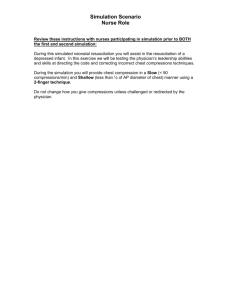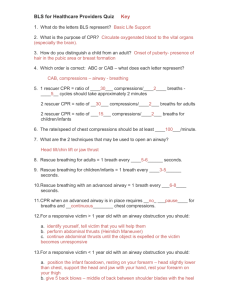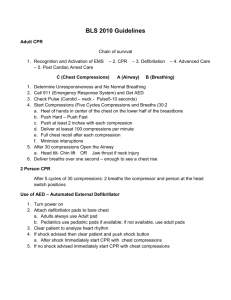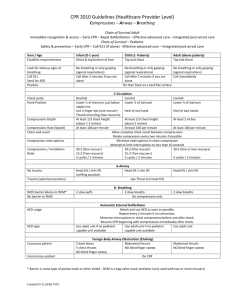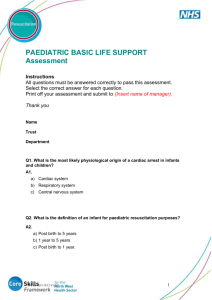Summary of CPR and AED Adults, Children and Infants for Health
advertisement
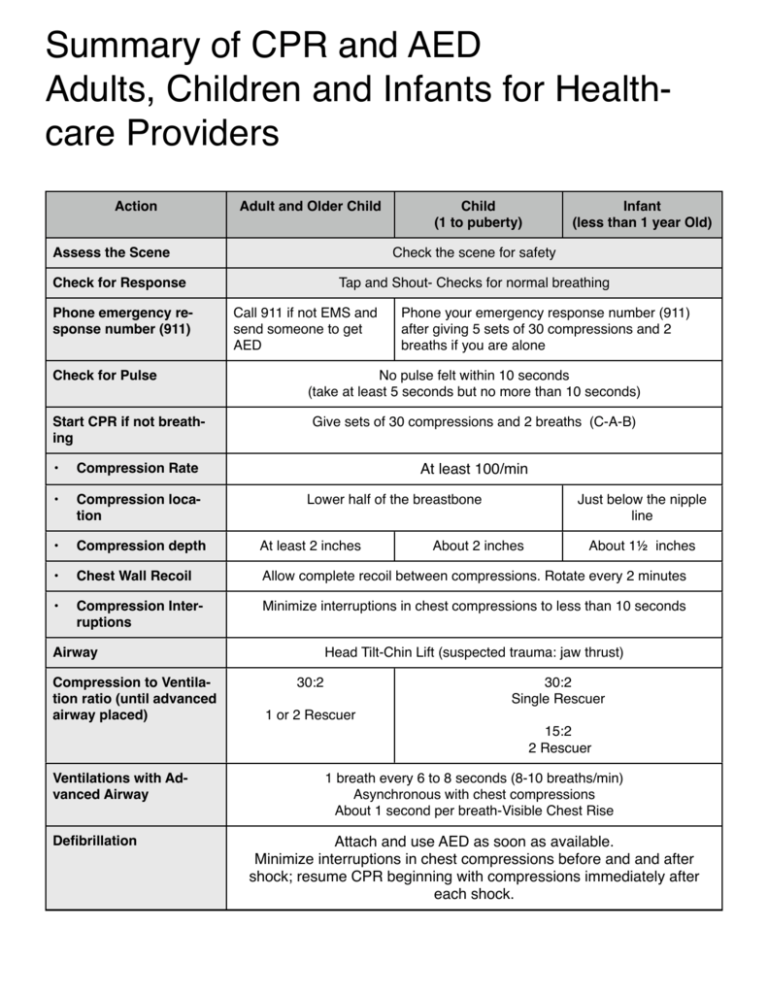
Summary of CPR and AED Adults, Children and Infants for Healthcare Providers Action Adult and Older Child Assess the Scene Check for Pulse Start CPR if not breathing Infant (less than 1 year Old) Check the scene for safety Check for Response Phone emergency response number (911) Child (1 to puberty) Tap and Shout- Checks for normal breathing Call 911 if not EMS and send someone to get AED Phone your emergency response number (911) after giving 5 sets of 30 compressions and 2 breaths if you are alone No pulse felt within 10 seconds (take at least 5 seconds but no more than 10 seconds) Give sets of 30 compressions and 2 breaths (C-A-B) • Compression Rate • Compression location • Compression depth At least 2 inches • Chest Wall Recoil Allow complete recoil between compressions. Rotate every 2 minutes • Compression Interruptions Minimize interruptions in chest compressions to less than 10 seconds At least 100/min Lower half of the breastbone Airway Compression to Ventilation ratio (until advanced airway placed) Just below the nipple line About 2 inches About 1½ inches Head Tilt-Chin Lift (suspected trauma: jaw thrust) 30:2 30:2 Single Rescuer 1 or 2 Rescuer 15:2 2 Rescuer Ventilations with Advanced Airway Defibrillation 1 breath every 6 to 8 seconds (8-10 breaths/min) Asynchronous with chest compressions About 1 second per breath-Visible Chest Rise Attach and use AED as soon as available. Minimize interruptions in chest compressions before and and after shock; resume CPR beginning with compressions immediately after each shock. Important Facts about CPR you need to know For chest compressions for all ages, it’s better to push too deep than not deep enough. Watching the chest rise is the best way to tell your rescue breaths are effective. Do not over-ventilate your patient when giving rescue breaths. A non-breathing child with a pulse above 60 beats per minute needs rescue breaths without compressions. Reassess pulse every 2 minutes. Begin compressions if pulse drops below 60 beats per minute. In the presence of an Advanced Airway do continuous compressions and non-stop rescue breathing at a rate of 1 breath every 6 to 8 seconds. Bag masks should only used in a two person rescue. After an AED delivers a shock immediately begin CPR. Do NOT reassess the victim. Place hands on the lower part of the breast bone for chest compressions. The 2 thumb technique for infant compressions is only used for 2 person rescue. 100 compressions per minute is the standard rate for all ages. Adult compression depth is “at least” 2 inches. Child “about” 2 inches, Infant “about 1.5 inches. Child and Infant use 15:2 compressions to breaths ratio when there are 2 rescuers. It is important to compress to correct depth to create adequate blood flow during compressions. When in doubt, push deeper. If you aren’t sure you are pushing deep enough, push deeper. The first step when using an AED is to Turn the Device ON. For a choking victim who becomes unresponsive: Call 911 then start CPR. Look in the mouth before providing a rescue breath. If you see anything in the mouth remove it. First step of any rescue is to “Make sure the scene is Safe” Check for pulse no more then 10 seconds. If there is no pulse or you’re not sure start CPR. CPR should be started within 10 seconds if there is no response, no breathing and no pulse. 2 person rescue one person does compressions the other does rescue breaths while maintaining open airway. BLS Healthcare Provider & Renewal Course Pre-course Review BLS CPR consists of 3 main components: 1. Compressions 2. Airway 3. Breathing Adult Chain of Survival: Early access: Establish Unresponsiveness/no breathing then activate EMS/911 Early CPR: Provide BLS/CPR within 4 minutes Early defibrillation: Have an AED on them and shocking within 5 minutes of the arrest Early advanced care: EMS/code team arriving soon there after. CPR - Adult Adult 1 rescuer CPR Check responsiveness (tap and shout), if no response: Check for no breathing (minimum 5 seconds; maximum 10 seconds) Activate emergency medical system and call for an AED Check for carotid pulse for (minimum 5 seconds; maximum 10 seconds) If there is no detectable pulse, start chest compressions at the lower part of the breastbone with the heal of one hand on top of the other. Do 30 compressions at least 2 inches deep. Give 2 breaths (1 second each) watching chest rise. Do not over ventilate. Deliver second cycle of 30 compressions. Give 2 breaths (1 second each) Continue CPR until help arrives or the victim is revived. Push Hard, and Push Fast: compress at a minimum rate of at least 100 compressions per minute and a depth of at least 2 inches, and allow full chest recoil after each compression. Minimize interruptions in chest compressions. Adult 2 Rescuer CPR: Ratio of 30 compressions to 2 breaths, Rate 100/minute or 5 cycles in 2 minutes (Ventilator) the rescuer at the head, (Compressor) the rescuer at the chest Ventilator determines responsiveness, if no response: Ventilator checks for no breathing or normal breathing (minimum 5 seconds; maximum 10 seconds) Compressor or bystander activates emergency medical system (call 911) and calls for an AED Ventilator checks for circulation, carotid pulse (minimum 5 seconds; maximum 10 seconds) If Victim has Pulse: Ventilator will provide rescue breaths for them: 1 breath every 5-6 seconds or about 10-12 per minute (each breath should be delivered over 1 second making the chest rise) If Victim has No Pulse: Compressor will start chest compressions, with the heel of two hands at a ratio of: 30 compressions by the compressor to 2 ventilations by the Ventilator at a rate of at least 100 per minute and a depth of at least 2” or deeper for larger person The Ventilator can check for a pulse during compressions to make sure they are effective by feeling a pulse every compression. After every 5 cycles or 2 minutes of CPR switch to maintain effective CPR. Advanced Airway Once the advanced airway is in place do NOT stop compressions for breaths DO CONTINUOUS COMPRESSIONS AND PERFORM 8 TO 10 BREATHS PER MINUTE (every 6 to 8 seconds), switch positions every 2 minutes or every 150 compressions. CHILD AND INFANT Pediatrics Chain of Survival: Prevention is #1 Early and effective CPR, for two minutes if alone Rapid activation of EMS or Call 911 Early and effective Advanced Life Support (EMS) (includes rapid stabilization and transport to definitive care and rehabilitation) Child (1 year of age to puberty) Puberty-look for: males-chest-facial-under arm hair, females-breast budding Child 1 rescuer CPR: Determine responsiveness Check for no breathing or normal breathing (minimum 5 seconds; maximum 10 seconds) Call for help-send bystander to call 911 or activate EMS. If no one comes you begin CPR and after 5 cycles or two minutes, you should activate 911/EMS. Check for circulation at the carotid artery for 5 seconds minimum; 10 seconds maximum If there is no detectable pulse, or pulse is less than 60 beats/min., start chest compressions at the lower part of the breastbone, at the depth of 1/3 of the child’s body or about 2” depth: Do 30 compressions Give 2 breaths (1 second each) watching the chest rise Deliver second cycle of 30 compressions Give 2 breaths (1 second each) Continue CPR at a ratio of 30 to 2 until help arrives. Push Hard, and Push Fast: compress at a minimum rate of 100 compressions per minute. Allow full chest recoil after each compression. Minimize interruptions in chest compressions. Child 2 rescuer: 15 compressions: 2 breaths, Rate = 100/min (Ventilator) the rescuer at the head, (Compressor) the rescuer at the chest Ventilator determines responsiveness, if no response: Check for no breathing or no normal breathing (minimum 5 seconds; maximum 10 seconds) Compressor or bystander calls 911 or activates EMS number Ventilator checks for circulation, carotid pulse > 60 beats/min. within 5-10 seconds If child has pulse greater than 60 beats/ min. Ventilator will rescue breath for them: 1 breath every 3 - 5 seconds or about 12 - 20 per minute (each breath should be delivered over 1 second making the chest rise) Recheck pulse every 2 minutes If the child does not have normal pulse or if pulse is less than 60 beats/min. Compressor will start chest compressions, with the heal of one hand or two at a ratio of: 15 compressions followed by 2 ventilations by the Ventilator at a rate of 100 per minute and a depth of 1/3 of the child’s body depth or 2” Switch places and reassess victim after 5 cycles Infant (0-1 YEAR OF AGE) CPR - Infant 1 rescuer CPR Determine unresponsiveness, if no response no breathing Call for help-if a bystander is present send them to call 911 or activate EMS. If no bystanders respond or present precede to: Check for pulse for 5-10 seconds: pulse (brachial or femoral) If the victim does not have pulse greater that 60 beats/min. Start chest compressions, 2 fingers one finger width below the nipple line, at a ratio of 30 compressions to 2 ventilations at a rate of at least 100 per minute and a depth of 1/3 of the infant’s body depth or 1 1⁄2” You activate EMS or call 911 if no-one is around after the first 5 cycles of CPR Then return to the infant & continue CPR If the infant has pulse greater than 60 beats/min provide: Rescue Breaths: 1 breath every 3 - 5 seconds for about 12 - 20 per minute (each breath should be delivered over 1 second making the chest rise) Recheck pulse every 2 minutes Infant 2 rescuer CPR: 15 compressions: 2 breaths, Rate = 100/min (Ventilator) the rescuer at the head, (Compressor) the rescuer at the chest Ventilator determines responsiveness, if no response Ventilator checks for no breathing or normal breathing (minimum 5 seconds; maximum 10 seconds) Compressor or bystander calls 911 or activates EMS Ventilator checks for circulation for 5-10 sec: pulse (brachial or femoral) >60 beats/min. If the victim has pulse greater than 60 beats/min. Ventilator will rescue breath for them: 1 breath every 3 - 5 seconds for about 12 - 20 per minute (each breath should be delivered over 1 second making the chest rise) Recheck pulse every 2 minutes If the victim does not have pulse greater than 60 beats/min. Ventilator will start chest compressions, with thumb encircling technique at a ratio of 15 compressions by the bystanders to 2 ventilations at a rate of at least 100 per minute and a depth of 1/3 of the infant’s body depth or 1 1⁄2”, switch aPer 5 cycles Push Hard, and Push Fast: compress at a minimum rate of 100 compressions per minute. Allow full chest recoil after each compression. Minimize interruptions in chest compressions. AED USE An Automated External Defibrillator (AED) is used when the heart stops beating normally and needs to be reset by an electric shock. The sooner the shock is delivered the better, since the probability of successful defibrillation diminishes rapidly over time. Provide 5 cycles of CPR, 30 compression to 2 breaths, for 2 minutes before using an AED on a child from 1 year to 8 or on an infant 1< of age. Special Considerations: Hairy chest-remove enough hair to get good contact with the skin. Dry chest if visibly wet. Implanted device-place pad at least 1 inch away from implant, never place pad on top of device. Medication patch-remove it and wipe area before pad placement. Note: Adult AED pads can be used on children and infants but pediatric pads are preferred. Pediatric pads can not be used on adults. For infants a manual defibrillator is preferred. If a manual defibrillator is not available, an AED with pediatric pads or a pediatric dose attenuator (plug-in shock reducing adapter) is desirable. If neither are available use Adult pads if that is all that is available. Choking Adult Conscious Choking Are you choking? Can you speak? Can I HELP you? Provide inward and upward Abdominal Thrusts, just above the navel. Adult Unconscious Choking: (NO BLIND FINGER SWEEPS) Call 911 Open the airway remove the object if you see it, then begin CPR (30 compressions to 2 breaths) Every time you open the airway to give breaths look for the object Then continue CPR (30 to 2) Choking - Child Conscious Choking: Are you choking? Can you speak? Can I HELP you? (ask the parent if you can help their child) Provide inward and upward abdominal thrust, just above the navel to relive the obstruction. Child Unconscious Choking: NO BLIND FINGER SWEEPS Call for help, send bystander to call 911 or activate EMS Open the airway, remove the object if you see it, then begin CPR, with a ratio of 30 compressions to 2 breaths. Every time you open the airway to give breaths look for the object. Then continue CPR with a ratio of 30 compressions to 2 breaths. If no one came to call 911 or activate EMS, you call after 2 minutes of CPR Infant Conscious Choking: Look for choking signs, like bluish skin, lips or nose, high-pitched noise Pick up the infant and give 5 back blows between the shoulder blades, with the head supported and with the head lower then the infant’s bottom Then flip the infant and provide 5 chest thrusts just below the nipple line, keeping the head lower that the infant’s bottom Repeat until infants able to cry or becomes unconscious Infant Unconscious Choking: NO BLIND FINGER SWEEPS Call for help, send bystander to call 911 or activate EMS Open the airway, remove the object if you see, begin CPR at a ratio of 30 to 2 Every time you open the airway to give breaths look for the object Then continue CPR at a ratio of 30 to 2 If no one came to call 911 or activate EMS, you call after 2 minutes or 5 cycles of CPR

